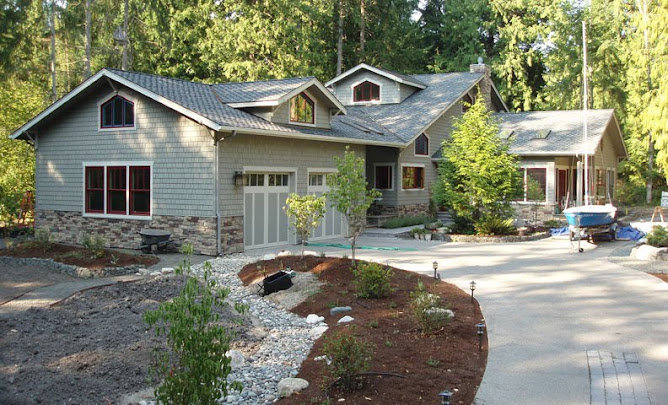So it took a week of work on and off to wire the garage, but there was training time and other chores in there too. I installed four 220 v lines (table saw, compressor, welder, etc) and about 12 outlets. I think there are 6 circuits for these. Then I put in the overhead lighting on 2 circuits. Overall it wasn't bad, but it was slow. It will go faster in the main house area now that I know what I'm doing. One of the bigger problems is deciding how to get wire to all the places. You don't want to drill through trusses and try to avoid the big lumber (like 4 x 6 beams), so there is come creative routes from switches to lamps.
Wire sizes: This is pretty straightforward. For overhead lighting we use 14-2 wire (white). This means 14 gage with two wires and a ground. Wire gages are ass backward. 14 is smaller than 12, and bigger than 16. Sort of think about it as no. of wires that can fit in an inch, i.e., 14 gage is roughly 1/14th inch thick. 14-3 has three wires and one ground and is used for 3 way switches (we'll have a dissertation on this subject once I've passed my qualifiers).
For the plug in receptacles (110 v), we use 12-2 wire (orange). If you need GFI protection (as in garage by code), you install a GFI receptacle in the first outlet and everything downstream is protected. GFI receptacles are used where water within 3 feet of outlet, or where there might be standing water on the floor (garage). You can put as many as 8-12 outlets on a single circuit, since they figure you can't be running more than a couple of tools simultaneously.
 For the 220 v. lines, we use 10-2 wire and have a single receptacle per circuit. For example, the 3- HP motor on my intended table saw would draw 25-30 amps at 110 v (too much for 12-2 wiring), but only draws half that amperage at 220 v, so you can supply power with 10-2 wire on a 20 amp circuit breaker. Problem solved, just more wires going to separate places.
For the 220 v. lines, we use 10-2 wire and have a single receptacle per circuit. For example, the 3- HP motor on my intended table saw would draw 25-30 amps at 110 v (too much for 12-2 wiring), but only draws half that amperage at 220 v, so you can supply power with 10-2 wire on a 20 amp circuit breaker. Problem solved, just more wires going to separate places.For the front end of the electrical system, we have an assemblage of panels and shut offs. Power comes in the house from the street (ground transformer) through 00 cable (1 1/4 inch thick, 220 volts, 3 cables) and uses a piece of rebar tied to the foundation for a ground. This cable will be underground in 4 inch gray PVC conduit, then enters the garage wall through a 90° bend (sweep) that we placed in the concrete footer. Then it goes up and into the meter box, which is within the garage framing. The meter is externally mounted and gets read electronically from the street. From the meter box power is routed to a main shut off panel (interior) and then goes to two panels: one 200 amp in the garage (for boy toys) and one 200 amp in the basement for the house and girl toys (ovens, lights, etc).
 After completing the garage and my basic wiring test (now I'm a rank amateur apprentice electrician), we took a week off to visit Denver and northern New Mexico on a mixed business trip and vacation. Managed to get our chili pepper tongues recalibrated and see a half dozen Denver couples for dinner and drinks. A successful trip, except for the excess baggage (personal weight gain) on the way back.
After completing the garage and my basic wiring test (now I'm a rank amateur apprentice electrician), we took a week off to visit Denver and northern New Mexico on a mixed business trip and vacation. Managed to get our chili pepper tongues recalibrated and see a half dozen Denver couples for dinner and drinks. A successful trip, except for the excess baggage (personal weight gain) on the way back.Now we've moved into the main house, putting up receptacle boxes and overhead (6" can) lights. 48 so far, with a few more smaller ones to be decided for lighting art work or specific parts of rooms, such as the kitchen counters and island.

